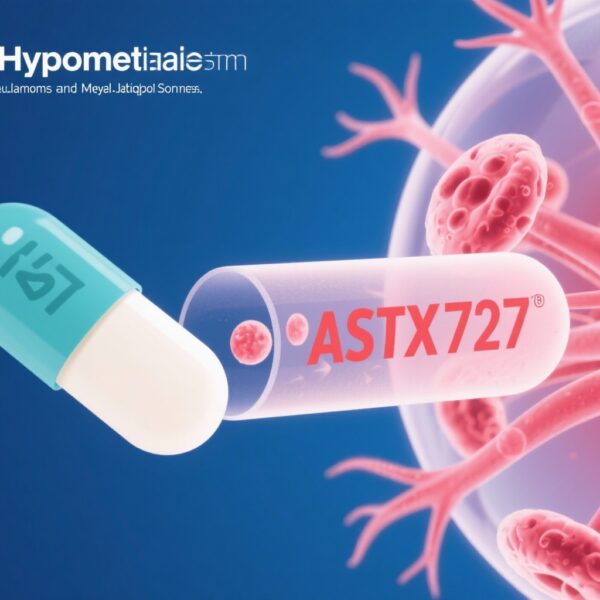Highlight
– Oral decitabine and cedazuridine (ASTX727) was evaluated as maintenance therapy post-allogeneic HSCT in very high-risk AML and MDS patients.
– Disease-free survival at 1 year post-transplant was 70.4% in the first 28 patients treated, suggesting promising efficacy.
– The safety profile was manageable, with grade 3 or higher hematological adverse events most common; one treatment-related death occurred.
– Donor lymphocyte infusion was integrated as a recommended adjunct post cycle 4, complementing maintenance therapy.
Study Background and Disease Burden
Acute myeloid leukemia (AML) and myelodysplastic syndrome (MDS) represent heterogeneous myeloid malignancies characterized by ineffective hematopoiesis and high relapse risk, particularly in patients with high-risk genetic and clinical profiles. Allogeneic hematopoietic stem-cell transplantation (HSCT) remains the only potentially curative therapy, but relapse post-transplantation remains a significant cause of mortality, especially in those classified as very high-risk. Traditional post-HSCT maintenance strategies aiming to reduce relapse risk have had mixed success; thus, novel approaches are essential.
Hypomethylating agents (HMAs) such as decitabine have demonstrated activity in AML and MDS by reversing aberrant DNA methylation, potentially eradicating residual malignant clones. Cedazuridine, a cytidine deaminase inhibitor, enables effective oral delivery of decitabine, allowing easier administration post-HSCT. Combining HMAs with donor lymphocyte infusion (DLI)—which can augment graft-versus-leukemia effects—is postulated to reduce relapse. The GFM-DACORAL-DLI study assesses this combined strategy’s efficacy and safety in a difficult-to-treat population.
Study Design
GFM-DACORAL-DLI was a multicentre, single-arm, phase 2 trial conducted in 12 centers across France. Eligible patients were aged 18 to 70 years with an ECOG performance status of 0-2, slated for HSCT, and meeting criteria for very high-risk disease defined by established prognostic scoring systems (poor or very poor Revised IPSS for MDS; adverse risk by 2017 ELN for AML) including unfavorable cytogenetics, AML arising post-MDS or myeloproliferative neoplasm, or relapse within 2 years of initial CR.
Patients were enrolled 5-45 days before transplant. Maintenance therapy with oral ASTX727 started approximately day 40 post-HSCT, administered in escalating doses starting at one day per 28-day cycle and increasing to three days, for up to ten cycles. Donor lymphocyte infusion was recommended after cycle 4 in patients without contraindications.
The primary endpoint was disease-free survival (DFS) at one year post-HSCT in the first 28 patients treated with ASTX727. Safety analyses included all patients receiving at least one dose of maintenance therapy. Enrollment spanned from September 2021 to March 2023, with follow-up ongoing.
Key Findings
Out of 59 patients screened, 51 underwent HSCT (median age 62 years; 43% female). Of these, 34 received maintenance with ASTX727; seven also received at least one DLI. Completion of all 10 maintenance cycles was achieved by 14 patients (41%). The median follow-up duration was 12.6 months.
Among the initial 28 patients evaluable for the primary endpoint, 1-year DFS was 70.4% (95% CI 55.1%-89.9%). This represents a promising signal given the high relapse risk of this cohort. Hematological toxicities were the most frequent grade 3 or higher adverse events, including neutropenia (62%), thrombocytopenia (24%), and anemia (12%). Serious adverse events were reported in 41% of patients, predominantly hematological and gastrointestinal in nature. There was one treatment-related death due to thrombocytopenia.
The incorporation of DLI post-cycle 4 introduced a cellular immune component intended to enhance graft-versus-leukemia activity, without apparent excess toxicity.
Expert Commentary
This study provides an important proof-of-concept that oral HMA maintenance with decitabine and cedazuridine can be feasibly administered after allogeneic HSCT in very high-risk AML/MDS populations. The 1-year DFS compares favorably with historical controls, though caveats include the single-arm design and relatively short median follow-up. The moderate completion rate for the full 10 cycles signifies challenges in prolonged therapy, likely reflecting cumulative toxicities and post-transplant complications.
The manageable safety profile, despite high rates of cytopenias, aligns with the expected toxicity profile of HMAs in this setting. Integration of DLI might enhance efficacy without clear additive toxicity, but its precise role requires elucidation in randomized settings. These results support potential incorporation of ASTX727 maintenance strategies into standard clinical practice if confirmed by larger randomized trials.
Potential limitations include lack of a control arm, sample size, and heterogeneity in risk factors and prior therapies. Generalizability outside experienced transplant centers necessitates further study. Current guidelines recommend consideration of maintenance strategies in high-risk post-HSCT AML/MDS; this trial contributes valuable data on an oral, convenient regimen.
Conclusion
The GFM-DACORAL-DLI phase 2 trial indicates that oral decitabine and cedazuridine maintenance therapy post-allogeneic HSCT may substantially improve disease-free survival in very high-risk AML and MDS patients. While hematological toxicity remains significant, the safety profile is manageable. Combined with donor lymphocyte infusion, this approach represents a promising therapeutic avenue for relapse prevention after transplantation. Further randomized controlled trials with longer follow-up are essential to firmly establish efficacy, optimize dosing schedules, and define patient subgroups most likely to benefit.
References
Robin M, D’Aveni M, Stamatoullas A, et al; Société Francophone de Greffe de Moelle et de Thérapie Cellulaire (SFGM-TC) and the Groupe Francophone des Myélodysplasies (GFM). Oral decitabine and cedazuridine maintenance after haematopoietic stem-cell transplantation in very high-risk acute myeloid leukaemia or myelodysplastic syndrome (GFM-DACORAL-DLI): a multicentre, single-arm, phase 2 trial. Lancet Haematol. 2025 Sep;12(9):e705-e716. doi:10.1016/S2352-3026(25)00172-3. Epub 2025 Aug 7. PMID: 40784355.
National Comprehensive Cancer Network. NCCN Clinical Practice Guidelines in Oncology: Acute Myeloid Leukemia. Version 4.2024.
Fenaux P, Mufti GJ, Hellstrom-Lindberg E, et al. Efficacy of azacitidine compared with that of conventional care regimens in the treatment of higher-risk myelodysplastic syndromes: a randomised, open-label, phase III study. Lancet Oncol. 2009;10(3):223-232. doi:10.1016/S1470-2045(09)70003-8.



